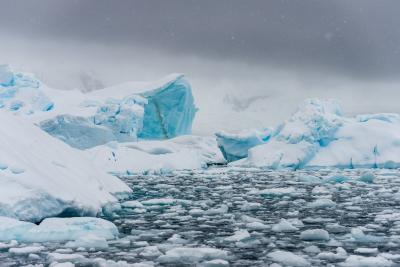Sensitivity of Sea Ice Albedo Feedback Estimates to the Calculation of Atmospheric Transmissivity
When sea ice at high latitudes melts, the ocean-ice surface becomes darker. A darker surface can absorb more sunlight, which warms the surface and further increases ice melt. This starts a positive feedback loop, called the sea ice albedo feedback, that amplifies warming at high latitudes. A team of scientists from the University of Washington and the U.S. Department of Energy’s Pacific Northwest National Laboratory developed and introduced a new method of calculating one of the terms important in estimating sea ice albedo feedback that is simple and easier than previous methods to perform. They then compared satellite observations and a large suite of model simulations using the new method. The researchers showed that there is more variability in that term than previously recognized and that the variability can primarily be attributed to differences in the model’s treatment of clouds. Accounting for this variability using the new method produces an estimate of sea ice albedo feedback that is 40 percent larger than when it was neglected following earlier practices.
Temperature changes, as well as associated changes in sea ice and clouds, at the poles affect many aspects of the planet, including weather and climate, as well as operations such as shipping and fishing. This study provides a new simple, efficient, and accurate method for estimating a feature of the atmosphere that improves understanding of changes occurring at high latitudes and helps quantify those changes.
Two factors influence sea ice albedo feedback: how much the reflectivity of the ocean-ice surface changes as the planet warms, and how much additional solar radiation the atmosphere absorbs as the surface reflectivity changes. The second factor—atmospheric radiation absorption—is frequently calculated using information about radiative transfer that is often unavailable in computer simulation output. This means previous studies have assumed that an estimate of this absorption based on a single model can be applied to different climate models.
To assess the validity of this assumption, the team first developed a new simple, computationally efficient way to calculate the atmospheric radiation absorption component of sea ice albedo feedback. Then they performed a complex, and accurate, calculation of the factors influencing sea ice albedo feedback in four models, and they compared the simpler and complex calculations. The researchers found that (1) the new, easier method agreed quite closely with the accurate calculation and (2) the variability across models is due to model differences in the models’ cloud features, not due to the way the models calculate sunlight scattering and absorption. Finally, they used their new technique to evaluate 18 climate models. including many in which fields needed to perform the complex accurate calculation were unavailable. The researchers showed that the variability among models in this factor was larger than previously estimated. This analysis also revealed that the ice albedo feedback is likely to be 40 percent larger than estimates made in previous assessments.

